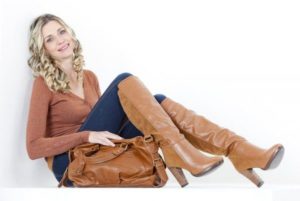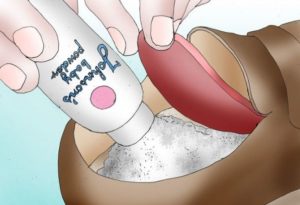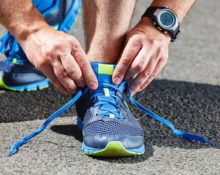New, just purchased boots or an old favorite suede pair suddenly began to make unpleasant sounds when walking. Or even worse - only one boot creaks and everyone present reacts ambiguously to this. Such situations are not uncommon. Unfortunately, not every cause can be treated, but you can try. So, what to do if a squeak appears when wearing it?
Why do boots squeak when walking?
Before attempting to get rid of this problem, you need to determine the source of the squeak. The sounds produced by the sole are different from the musical accompaniment emanating from the leather or heel. Walk on different surfaces, sometimes stepping on the sole and heel with force, sometimes raising your foot and rotating it slightly. When the cause of the squeak becomes clear, you can try to get rid of it.
Bad material
 High-quality shoes do not squeak. Low grade leather can make unpleasant sounds when walking.The material that is not suitable for the production of shoes, which ended up in tailoring, is precisely the reason for the “musicality” of the boots. It is almost impossible to get rid of such sounds. This is a clear manufacturing defect and the pair must be returned.
High-quality shoes do not squeak. Low grade leather can make unpleasant sounds when walking.The material that is not suitable for the production of shoes, which ended up in tailoring, is precisely the reason for the “musicality” of the boots. It is almost impossible to get rid of such sounds. This is a clear manufacturing defect and the pair must be returned.
If your old boots squeak, then your lack of care for your shoes is to blame - the pair has dried out or singing microcracks have formed. In this case, there are ways to get rid of sounds.
Or maybe you walk on such a surface?
Sometimes squeaking occurs only when walking on certain types of surfaces: linoleum, laminate, chipboard. And in other cases there are no sounds. Walk over the surface several times to determine the source of the noise. Do the boots actually squeak or is it the coating that makes it? Most likely, you are simply scared of this problem and hear something that is not really there.
New boots squeak...
 When buying new shoes, it is important to choose really high-quality products so that they can be worn for a long time and with comfort. If the creaking arose even at the stage of trying on in the store, put this pair in place and select other options for yourself. If unpleasant sounds occur during the warranty period, the boots can be returned to the store.
When buying new shoes, it is important to choose really high-quality products so that they can be worn for a long time and with comfort. If the creaking arose even at the stage of trying on in the store, put this pair in place and select other options for yourself. If unpleasant sounds occur during the warranty period, the boots can be returned to the store.
The seller is obliged to accept a defective pair (that is exactly what it is), offering another one in return or returning the money. These shoes cannot be used.
If it's the sole...
The process of use inevitably entails changes in the appearance and structure of the skin. It becomes rougher, stretches in some places, and forms microcracks. The sole is also subject to these processes. If the creaking comes from the fact that microcracks have formed in the sole or on the surface of the skin, then you should use one of the proven folk remedies:
 rub the boots at night - both the soles and the skin in places where there is a possible squeak - with a mixture of melted wax and goose fat (in a ratio of 1:3);
rub the boots at night - both the soles and the skin in places where there is a possible squeak - with a mixture of melted wax and goose fat (in a ratio of 1:3);- leave to absorb overnight;
- In the morning, remove the excess with a swab dipped in any alcohol-containing liquid.
- Important! Alcohol is sometimes used in folk recipes to eliminate one or another defect in shoes. Be careful when working with it, because it degreases the skin, making it thin, fragile, inelastic and brittle.
A solution to the problem may be a very wet rag on which the boots are left overnight. The sole will absorb moisture until the morning and, having become softer, will simply stop making unpleasant sounds. If you encounter this problem again after some time, repeat the procedure. You don't risk anything.
Important! This method is short-lived and cannot be used for shoes made of suede or nubuck.
And one more way. Using a regular household hair dryer operating at medium power, apply pressure to the squeaky area of the sole. After 7–10 minutes, simply knead the soft sole by hand. Microcracks are filled with softened rubber, and the sound disappears.
What if the reason is the heel?
 Make sure this is the case. If this is actually the case, then you should contact a shoemaker for help. Only a professional can work with loose heels, instep supports, and heels. When the necessary skills are present and the right tools are available, this problem can be dealt with at home.
Make sure this is the case. If this is actually the case, then you should contact a shoemaker for help. Only a professional can work with loose heels, instep supports, and heels. When the necessary skills are present and the right tools are available, this problem can be dealt with at home.
If the squeak comes from the junction of the heel and the base, lubricate it with fat, cream, or better yet, inject a couple of drops of some oil with a syringe. Perhaps the problem will be solved by this action.
Important! When it is not the heel that creaks, but the rubber heel, it is recommended to lubricate it with oil or grease. But be careful, it is not safe - use the method only for stable low heels of medium size.
Ways to get rid of squeaky boots
 Sometimes shoe polish eliminates squeaking. It needs to be washed, dried and thoroughly treated with cream, leaving the steam overnight for absorption. In the morning, simply polish your boots with a soft cloth. To avoid problems with squeaking later, take care of your shoes regularly.
Sometimes shoe polish eliminates squeaking. It needs to be washed, dried and thoroughly treated with cream, leaving the steam overnight for absorption. In the morning, simply polish your boots with a soft cloth. To avoid problems with squeaking later, take care of your shoes regularly.
If the sound comes from tightly stretched seam threads, then castor oil or burning wax, acting on the stitching areas, will warm up and slightly stretch the threads. The tension will weaken and the sound will disappear.
Leather substitute boots can be wrapped in a wet cloth and left overnight to absorb moisture into the outer layer. Once soft, the surface or sole will stop making extraneous sounds.
In leather boots
 Leather as a material is quite elastic. It stretches and contracts to take the anatomical shape of the foot. In places where there are stretches and bends, it is most susceptible to microcracks. Before going outside, treat your boots from time to time with special impregnations that prevent them from getting wet and repel dirt.
Leather as a material is quite elastic. It stretches and contracts to take the anatomical shape of the foot. In places where there are stretches and bends, it is most susceptible to microcracks. Before going outside, treat your boots from time to time with special impregnations that prevent them from getting wet and repel dirt.
All this affects premature wear, drying of the leather and deepening of cracks under the influence of sand and pebbles getting into the shoes.
Change the insole?
A poorly glued insole can be a source of squeaking. This is easy to deal with - you should carefully tear it off and, straightening it, re-glue it. It is necessary to control the process and not allow the materials to rub against each other. If the insole is simply worn out, you need to replace it with a new one.Another part can be bought in a store or cut out of leather at home yourself.
Folk remedies against squeaking
There are many ways to get rid of such a nuisance as squeaking. All of them are used at home, are easy to use and do not require expensive or rare products.
Castor oil
 wash your shoes and dry them;
wash your shoes and dry them;- Treat the entire surface of the boots with slightly warmed castor oil;
- Rub it thoroughly into the skin and leave overnight to absorb;
- Instead of castor oil, you can use the one you have in the house. The result will also be excellent.
Vaseline against squeaky skin
- Apply a thick layer of Vaseline to washed and dried shoes;
- allow it to absorb for 10–12 hours;
- Remove residues with a soft cloth.
Fighting sounds from excess moisture
 dry the pair well;
dry the pair well;- pour a little talc into each boot and give it a couple of hours to absorb the remaining excess;
- remove the talc and treat the leather surface with cream;
- Instead of talc, you can take starch or table salt.
Eliminating the musicality of the sole
- we are looking for a place that is the source of sound;
- if the problem is dirt and sand, then we clean the peeled sole and skin from dirt;
- then glue it to the base;
- place under a press for several hours;
- Lubricate the skin with cream or fat.
Castor oil (drying oil)
 lubricate the soles of the boots with castor oil or drying oil;
lubricate the soles of the boots with castor oil or drying oil;- when working with the latter remedy, take a very limited amount and treat the surface of the sole very carefully, without getting it on the skin;
- After treatment, give the product time to get rid of the specific smell, for example, on the balcony.
Baby powder
- rub it into the sole, treat the product outside and inside;
- the powder will remove moisture from all parts with which it interacts, give it several hours for this;
- remove the compound, due to the increased adhesion of all parts to each other, the squeak will disappear.
Wax or paraffin
Paraffin, which can be purchased at a hardware store, is also ready to help eliminate unpleasant sounds:
 treat the surface of the sole outside and inside;
treat the surface of the sole outside and inside;- leave for some time to absorb;
- remove excess by simply removing it with your hand;
- the remedy relieves the problem only temporarily; after a certain period, repeated manipulations will be required.
Preventing squeaking
 It is better to prevent a disease than to treat it. The best prevention is daily careful shoe care. If your boots get wet, be sure to dry them with a special electric dryer or using newspapers. Replace wet sheets with dry ones until the moisture is absorbed. In this case, shoes should be kept away from heating sources and direct sunlight, and the room should be well ventilated.
It is better to prevent a disease than to treat it. The best prevention is daily careful shoe care. If your boots get wet, be sure to dry them with a special electric dryer or using newspapers. Replace wet sheets with dry ones until the moisture is absorbed. In this case, shoes should be kept away from heating sources and direct sunlight, and the room should be well ventilated.
Immediately treat new shoes with water- and dirt-repellent agents. Repeat this procedure from time to time, renewing the protective layer on the surface of the skin.
In the evening, after returning home, wash and dry your boots. After drying, treat them with special daily care products - cream, spray, selecting them for your skin type.
If you don’t have cream on hand, take folk remedies:
- fat, lard, Vaseline for leather boots;
- olive or flaxseed oil for fair skin;
- sleepy coffee - for brown boots;
- starch - from stains on suede.
For long-term storage, fill the boots with paper to maintain their shape.Place them in a perforated shoebox and keep them cool and dark.
Never take off your shoes by stepping on the heel - the heels will wobble, creak, and the skin in this place will become deformed.


 rub the boots at night - both the soles and the skin in places where there is a possible squeak - with a mixture of melted wax and goose fat (in a ratio of 1:3);
rub the boots at night - both the soles and the skin in places where there is a possible squeak - with a mixture of melted wax and goose fat (in a ratio of 1:3); wash your shoes and dry them;
wash your shoes and dry them; dry the pair well;
dry the pair well; lubricate the soles of the boots with castor oil or drying oil;
lubricate the soles of the boots with castor oil or drying oil; treat the surface of the sole outside and inside;
treat the surface of the sole outside and inside; 0
0





